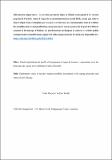Étude exploratoire de profils d’enseignants à risque de burnout : association avec les processus de coping et le sentiment d’auto-efficacité
Exploratory study of teacher burnout profiles: Association with coping processes and sense of self-efficacy

Type de référence
Date
2024-09Langue de la référence
FrançaisEntité(s) de recherche
Résumé
Introduction. Le burnout et ses prédicteurs sont une problématique de santé importante en population enseignante.
Objectif. Cette étude visait à identifier des profils d’enseignants à risque de burnout, et examiner leurs associations avec les processus de coping et le sentiment d’auto-efficacité (SAE) selon une double approche centrée sur les variables et sur la personne.
Méthode. Un échantillon de 171 enseignants (58,50 % de femmes) d’un canton de Suisse romande a complété le Shirom-Melamed Burnout Measure, la Teachers’ Sense of Efficacy Scale et l’échelle de Coping de Dewe.
Résultats. Le coping Problème était la seule variable qui prédisait négativement les trois dimensions du burnout. Le coping Évitant prédisait négativement la fatigue physique et la lassitude cognitive, alors que le SAE en gestion de classe prédisait négativement l’épuisement émotionnel. Des résultats complémentaires ont suggéré le rôle modérateur du nombre d’élèves ayant des besoins éducatifs particuliers (BEP) dans la relation entre certaines variables. Trois profils ont été identifiés à l’aide d’une analyse de classification hiérarchique. Des analyses de régression logistique multinomiale ont montré qu’un nombre élevé d’élèves ayant des BEP en classe, ainsi que des niveaux faibles de coping problème, coping évitant et SAE en gestion de classe étaient associés à une plus grande probabilité d’appartenir au profil ayant un risque élevé de burnout (représentant 21,64 % de l’échantillon total).
Conclusion. Les résultats mettent non seulement en évidence un nombre relativement important d’enseignants présentant un risque de burnout élevé, mais également une possible action conjointe de certains processus de coping et du SAE.
Résumé traduit en anglais
Introduction. Burnout and its predictors are an increasingly important health issue in the teaching profession. Objective. The present study aimed at identifying teacher profiles at risk of burnout, and to explore their associations with coping processes and sense of self-efficacy using a dual variable and person-centered approach. Method. A sample of 171 teachers (58.50% female) from a French-speaking canton of Switzerland completed the Shirom-Melamed Burnout Measure (i.e., physical fatigue, cognitive weariness, emotional exhaustion), the Teachers’ Sense of Efficacy Scale (i.e., instructional strategies, student engagement, classroom management) and the Coping Scale by Dewe (i.e., need to communicate, traditional style of teaching, problem-focused and avoidant coping). Results. Problem-focused coping was the only variable that negatively predicted all three dimensions of burnout. Avoidant coping negatively predicted physical fatigue and cognitive weariness while classroom management self-efficacy negatively predicted emotional exhaustion. Additional findings suggested the moderating role of the number of students with special educational needs (SEN) in the relationship between some variables. Three profiles were identified based on a hierarchical cluster analysis. Multinomial logistic regression analysis showed that a higher number of students with SEN, as well as low levels of coping (i.e., problem-focused and avoidant) and sense of self-efficacy in classroom management were associated with a greater likelihood of belonging to the burnout risk profile (representing 21.64% of the total sample). Conclusion. Findings from this study not only highlight a relatively large proportion of teachers at risk of burnout, but also a possible co-action of some coping processes and sense of self-efficacy.Titre du périodique
Psychologie françaiseMaison d’édition
ElsevierPays d'édition
Francep-ISSN
0033-2984Evaluation par les pairs (peer reviewing)
ouiPortée nationale / internationale
internationaleVolume / tome
69Fascicule
3Pagination
247-268Public(s) cible(s)
Chercheursprofessionels du domaine
Etudiants
URL permanente ORFEE
http://hdl.handle.net/20.500.12162/7050Autre(s) URL(s) permanente(s)
http://doi.org/10.1016/j.psfr.2023.10.002https://www.sciencedirect.com/science/article/pii/S0033298423000766
Document(s) associé(s) à la référence
Texte intégral :
Fichier
Accès
Commentaire
Version
Taille
- Tout ORFEE
- Détail référence



